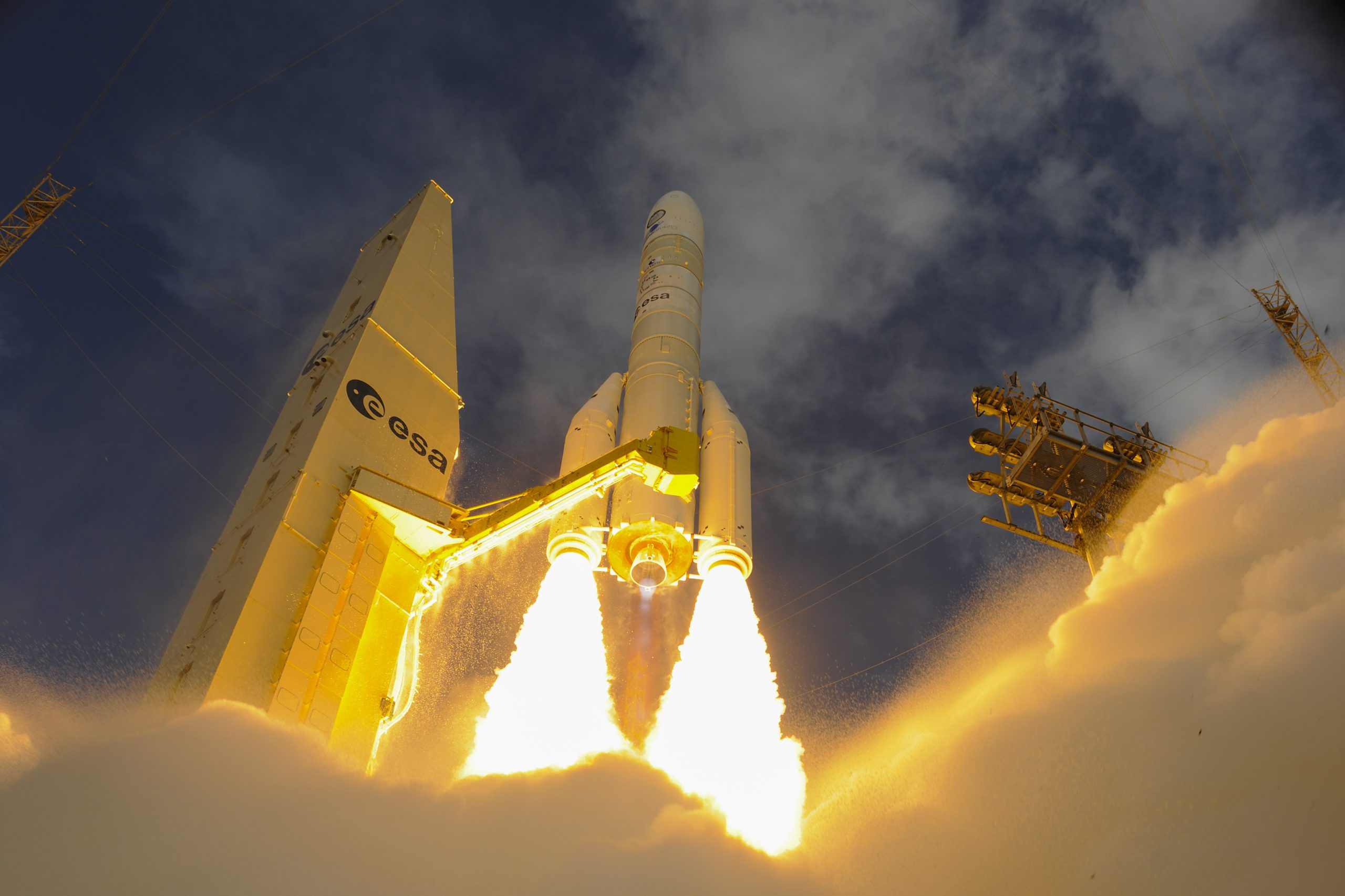Europe’s new heavy-lift rocket, Ariane 6, made its inaugural flight from Europe’s Spaceport in French Guiana on 9th July.
Ariane 6 is the latest in Europe’s Ariane rocket series, taking over from Ariane 5, and featuring a modular and versatile design that can launch missions from low-Earth orbit and farther out into deep space.
Europe is back in space! #Ariane6 demonstrated a successful liftoff, launch to orbit and deployment of satellites powering Europe into space.
The tech-demo phase of Ariane 6 is still in progress but has shown an unexpected result which will only affect the end of the mission.… pic.twitter.com/1VBzQ25Q3o
— European Space Agency (@esa) July 9, 2024
“A completely new rocket is not launched often, and success is far from guaranteed. I am privileged to have witnessed this historic moment when Europe’s new generation of the Ariane family lifted off – successfully – effectively reinstating European access to space,” said ESA’s Director General Josef Aschbacher.
We have made history for Europe.#Ariane6 pic.twitter.com/hUO3sh1K09
— Josef Aschbacher (@AschbacherJosef) July 9, 2024
“An inaugural launch is a huge undertaking from thousands of people who have worked relentlessly for years. To see it perform wonderfully at the first attempt is testament to their dedication and a demonstration of European excellence in engineering and technology. Not always easy, but the endurance shown has paid off handsomely today,” he added.
C'est notre Histoire spatiale.
C'est notre autonomie stratégique.
C'est une fierté française et européenne.Le premier lancement d'Ariane 6 est un succès !
Immense bravo aux équipes qui rendent possible ce qui paraît impossible. Mission accomplie. pic.twitter.com/yDylqdkQKr
— Emmanuel Macron (@EmmanuelMacron) July 9, 2024
This inaugural flight, designated VA262, is a demonstration flight whose aim is to show the capabilities and prowess of Ariane 6 in escaping Earth’s gravity and operating in space. Nevertheless, it had several passengers on board.
In addition to the rocket, the liftoff demonstrated the functioning of the launch pad and operations on the ground at Europe’s Spaceport. The new custom-built dedicated launch zone was built by France’s space agency CNES and allows for a faster turnover of Ariane launches.
On the occasion of the launch, Philippe Baptiste, CEO of CNES, said: “With this first successful launch by Ariane 6, Europe has finally recovered its capacity to access space. Europe can be proud of its space programme, Europe can be proud of its knowledge and expertise. Together, let’s prepare the future of launchers and space.”
Succès majeur pour l’Europe spatiale!
🚀🇪🇺Lancement inaugural réussi pour #Ariane6, la nouvelle fusée européenne.
C’est un élément crucial pour notre autonomie d’accès à l’espace.
Bravo aux équipes d’Arianespace, de l’ESA et du CNES.#EUspace #Souveraineté pic.twitter.com/XRtB4bCq8t
— Thierry Breton (@ThierryBreton) July 9, 2024
Ariane 6 was built by prime contractor and design authority ArianeGroup. “With the successful first flight of Ariane 6, the European space industry has moved into a new era,” said Martin Sion, CEO of ArianeGroup. “Seeing Europe’s new launcher lift off into space marks the culmination of an outstanding technical and technological adventure, and the beginning of a long history of Ariane 6 operations. The next flight models are already in production and the stages of the second model will be shipped to the Guiana Space Centre this autumn for the first commercial flight of Ariane 6.”
Why Ariane 6 is special for Europe?
Ariane 6’s launch is special for Europe because they have suffered a series of blows which includes the delay of the same rocket by four years. Due to which the Europe has had to rely on rivals such as Elon Musk’s SpaceX for the launches.
So far out of 117 launches in over nearly 2 decades, Europe faced only one failed attempt that is of the Ariane 5 flight.
The European Space Agency initiated the Ariane 6 program in 2014 to maintain Europe’s leadership in the global space race. The program aimed to develop a more cost-effective and versatile launcher for two decades to replace the reliable workhorse Ariane 5.
“After a decade of development and an investment of approx. €4 billion the Ariane 6 has finally taken flight, not without extreme heart rate, due to sad memories of the Ariane 5 maiden launch, which ended in a catastrophe,” writes Meidad Pariente, Chief Engineer, Sky Space Global Limited.
Europe’s achievement
With the placement of satellites into orbit, Ariane 6 has demonstrated that it can successfully launch its payloads into space, but ground control has more in store for its inaugural flight.
On this flight the Ariane 6 upper stage is set to release two re-entry capsules as it enters Earth’s atmosphere for a clean disposal to burn up harmlessly, leaving no space debris in orbit.
The next Ariane 6 is planned for launch this year on its first commercial flight under Arianespace as operator and launch service provider.
“The success of this first flight marks the start of Ariane 6’s operational career, giving Europe an autonomous access to space,” added Stéphane Israël, CEO of Arianespace. “The new launcher’s order book is proof of the versatility of Ariane 6 and of its capacity to accomplish a wide range of missions into multiple orbits.”
Ariane 6 launcher is expected to play a crucial role in Europe’s future space missions, including satellite launches, human spaceflights, and deep-space exploration. The ESA plans to conduct several more Ariane 6 launches in the coming years to validate the launcher’s performance and reliability.
The setbacks European Space faced
Ariane 6, standing more than 200 feet tall, is about a $4.5 billion program overseen by the European Space Agency and built by Ariane Group, a joint venture of Airbus and Safran. It was originally planned to launch in 2020 but since then it has been repeatedly delayed.
Russia suspended all European mission launches on its Soyuz rockets after it attacked Ukraine in 2022. A smaller alternative European rocket, the Vega-C has been grounded since a failed 2022 launch, and is not expected to fly again until later this year at the earliest.
Last month Europe’s weather satellite operator Eumetsat informed that it would launch its next satellite on a Falcon 9 instead of the initially planned Ariane 6.
The decision did not go down well with the European officials, and it exposed the tensions that have simmered over Europe’s space ambitions.
ESA has launched an initiative to boost small-launcher projects that could pave the way for a future private player.
Ariane 6 has 29 missions to launch over the next several years and aims for up to 12 flights a year. That includes 18 launches for Amazon’s Kuiper internet constellation.








